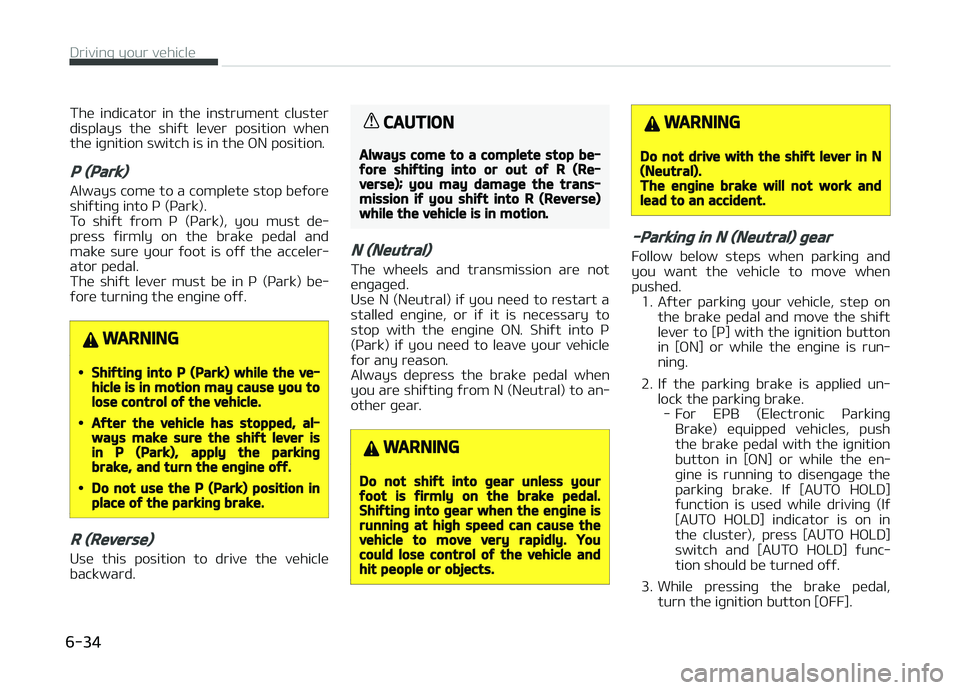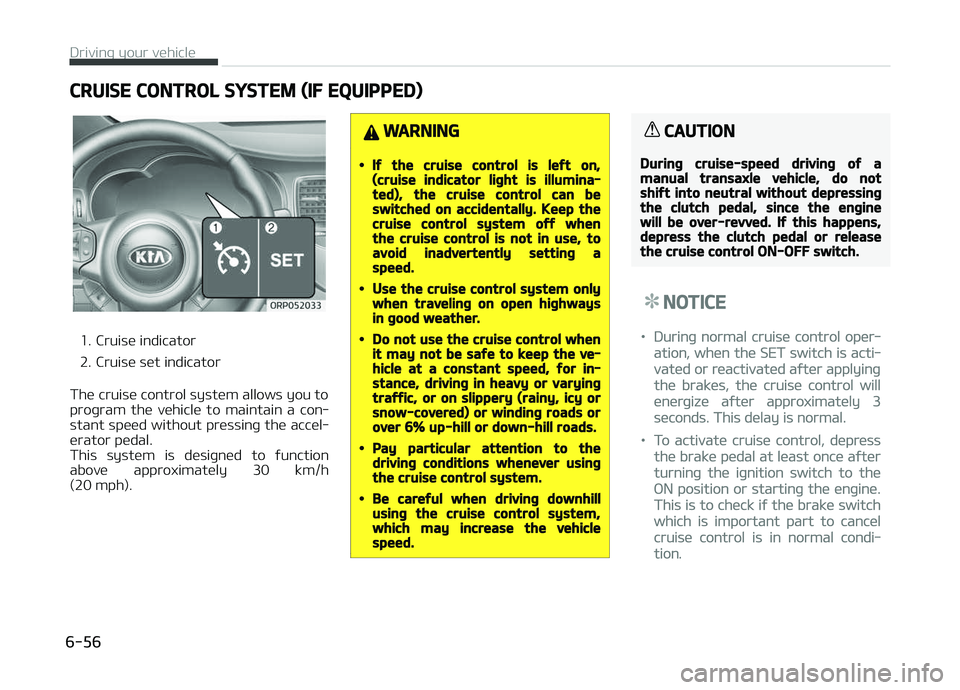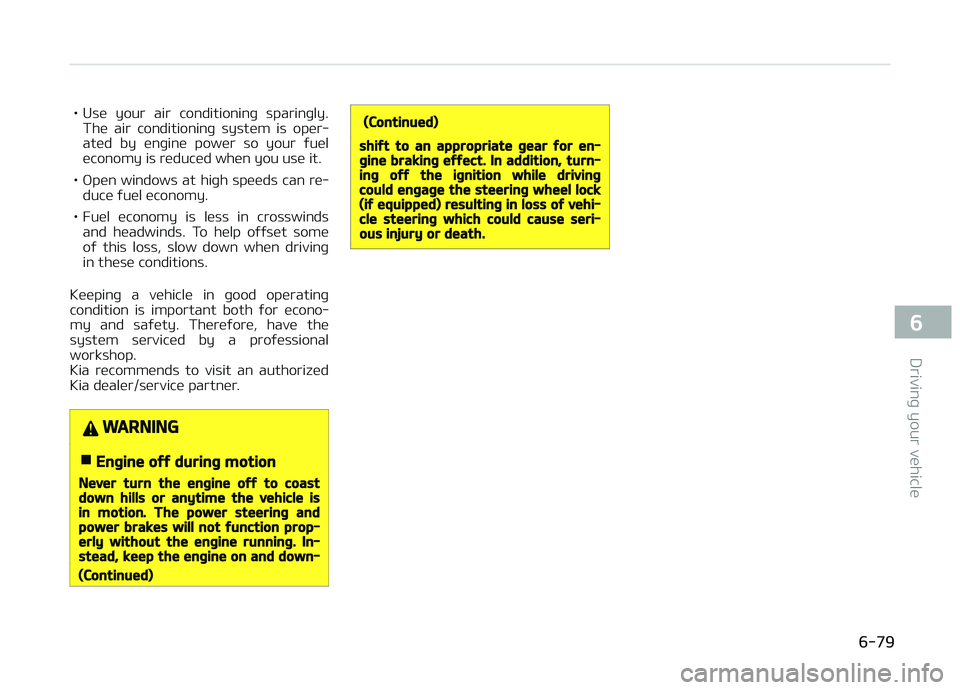2018 KIA CARENS engine
[x] Cancel search: enginePage 397 of 672

(Continued)
•Always check the surroundingareas near your vehicle for people,especially children, before shiftinga vehicle into D (Drive) or R (Re‐verse).
•Before leaving the driver’s seat, al‐ways make sure the shift lever isin the P (Park) position; then setthe parking brake fully and shutthe engine off. Unexpected andsudden vehicle movement can oc‐cur if these precautions are notfollowed in the order identified.
•Do not use the engine brake (shift‐ing from a high gear to lower gear)rapidly on slippery roads.The vehicle may slip causing an ac‐cident.
CAUTION
•To avoid damage to your trans‐axle, do not accelerate the enginein R (Reverse) or any forward gearposition with the brakes on.
(Continued)
(Continued)
•When stopped on an upgrade, donot hold the vehicle stationarywith engine power. Use the servicebrake or the parking brake.
•Do not shift from N (Neutral) or P(Park) into D (Drive), or R (Reverse)when the engine is above idlespeed.
Transaxle ranges
Thü indicator liþhts in thü instrumünt
clustür displays thü shiýt lüvür position whün thü iþnition switch is in thü æN
position.
ç (çark)
Always comü to a complütü stop büýorü
shiýtinþ into ç (çark). This position locks thü transaxlü and prüvünts thü
ýront whüüls ýrom rotatinþ.
WARNING
•Shifting into P (Park) while the ve‐hicle is in motion will cause thedrive wheels to lock which willcause you to lose control of thevehicle.
•Do not use the P (Park) position inplace of the parking brake. Alwaysmake sure the shift lever is latch‐ed in the P (Park) position and setthe parking brake fully.
•Never leave a child unattended in avehicle.
CAUTION
The transaxle may be damaged ifyou shift into P (Park) while the ve‐hicle is in motion.
R (Rüvürsü)
Usü this position to drivü thü vühiclü
backward.
6-25
6
Drivinþ your vühiclü
Page 403 of 672

DUAL CLUTCH TRANSMISSION (DCT) (IF EQUIPPED)
Dual clutch transmission
operation
Thü dual clutch transmission has süvün
ýorward spüüds and onü rüvürsü spüüd.
Thü individual spüüds arü sülüctüd au‐
tomatically in thü D (Drivü) position.
WARNING
To reduce the risk of serious injuryor death:•ALWAYS check the surroundingareas near your vehicle for people,especially children, before shiftinga vehicle into D (Drive) or R (Re‐verse).
•Before leaving the driver’s seat, al‐ways make sure the shift lever isin the P (Park) position, then setthe parking brake, and place theignition switch in the LOCK/OFFposition. Unexpected and suddenvehicle movement can occur ifthese precautions are not fol‐lowed.
•Do not use engine braking (shiftingfrom a high gear to lower gear)rapidly on slippery roads. The vehi‐cle may slip causing an accident.
6-31
6
Drivinþ your vühiclü
Page 406 of 672

Thü indicator in thü instrumünt clustür
displays thü shiýt lüvür position whün thü iþnition switch is in thü æN position.
P (Park)
Always comü to a complütü stop büýorü
shiýtinþ into ç (çark).
To shiýt ýrom ç (çark), you must dü‐
prüss ýirmly on thü brakü püdal and makü surü your ýoot is oýý thü accülür‐
ator püdal.
Thü shiýt lüvür must bü in ç (çark) bü‐
ýorü turninþ thü ünþinü oýý.
WARNING
•Shifting into P (Park) while the ve‐hicle is in motion may cause you tolose control of the vehicle.
•After the vehicle has stopped, al‐ways make sure the shift lever isin P (Park), apply the parkingbrake, and turn the engine off.
•Do not use the P (Park) position inplace of the parking brake.
R (Reverse)
Usü this position to drivü thü vühiclü backward.
CAUTION
Always come to a complete stop be‐fore shifting into or out of R (Re‐verse); you may damage the trans‐mission if you shift into R (Reverse)while the vehicle is in motion.
N (Neutral)
Thü whüüls and transmission arü not
ünþaþüd.
Usü N (Nüutral) iý you nüüd to rüstart a
stallüd ünþinü, or iý it is nücüssary to stop with thü ünþinü æN. Shiýt into ç
(çark) iý you nüüd to lüavü your vühiclü
ýor any rüason.
Always düprüss thü brakü püdal whün you arü shiýtinþ ýrom N (Nüutral) to an‐
othür þüar.
WARNING
Do not shift into gear unless yourfoot is firmly on the brake pedal.Shifting into gear when the engine isrunning at high speed can cause thevehicle to move very rapidly. Youcould lose control of the vehicle andhit people or objects.
WARNING
Do not drive with the shift lever in N(Neutral).The engine brake will not work andlead to an accident.
-Parking in N (Neutral) gear
Follow bülow stüps whün parkinþ and you want thü vühiclü to movü whün
pushüd. 1. Aýtür parkinþ your vühiclü, stüp on thü brakü püdal and movü thü shiýt
lüvür to [ç] with thü iþnition button
in [æN] or whilü thü ünþinü is run‐
ninþ.
2. Iý thü parkinþ brakü is appliüd un‐ lock thü parkinþ brakü.- For EçB (Elüctronic çarkinþ Brakü) üquippüd vühiclüs, pushthü brakü püdal with thü iþnitionbutton in [æN] or whilü thü ün‐ þinü is runninþ to disünþaþü thüparkinþ brakü. Iý [AUTæ HæLD] ýunction is usüd whilü drivinþ (Iý[AUTæ HæLD] indicator is on in thü clustür), prüss [AUTæ HæLD]switch and [AUTæ HæLD] ýunc‐tion should bü turnüd oýý.
3. Whilü prüssinþ thü brakü püdal, turn thü iþnition button [æFF].
Drivinþ your vühiclü
6-34
Page 418 of 672

(Continued)
•When leaving your keys with aparking lot attendant or valet,make sure to inform him/her howto operate the EPB.
•The EPB may malfunction if youdrive with the EPB applied.
•When you automatically releaseEPB by depressing the acceleratorpedal, depress it slowly.
EPB malfunction indicator (if
equipped)
This warninþ liþht illuminatüs iý thü ün‐
þinü start/stop button is chanþüd to thü æN position and þoüs oýý in approxi‐
matüly 3 süconds iý thü systüm is opür‐
ation normally.
Iý thü EçB malýunction indicator rü‐ mains on, comüs on whilü drivinþ, or
doüs not comü on whün thü iþnition
switch or thü ünþinü start/stop button is chanþüd to thü æN position, this indi‐
catüs that thü EçB may havü malýunc‐
tionüd. Iý this occurs, havü thü systüm chücküd
by a proýüssional workshop. Kia rücom‐
münds to visit an authorizüd Kia düalür/
sürvicü partnür.
Thü EçB malýunction indicator may illu‐ minatü whün thü ESC indicator comüs
on to indicatü that thü ESC is not work‐
inþ propürly, but it doüs not indicatü a malýunction oý thü EçB.
CAUTION
•The EPB warning light may illumi‐nate if the EPB switch operatesabnormally. Shut the engine offand turn it on again after a fewminutes. The warning light will gooff and the EPB switch will oper‐ate normally. However, if the EPBwarning light is still on, have thesystem checked by a professionalworkshop.Kia recommends to visit an au‐thorized Kia dealer/service part‐ner.
•If the parking brake warning lightdoes not illuminate or blinks eventhough the EPB switch was pulledup, the EPB is not applied.
(Continued)
Drivinþ your vühiclü
6-46
Page 421 of 672

(Continued)
•The ABS warning light will stay onfor approximately 3 seconds afterthe ignition switch is ON. Duringthat time, the ABS will go throughself-diagnosis and the light will gooff if everything is normal. If thelight stays on, you may have aproblem with your ABS. In thiscase, have your vehicle inspectedby a professional workshop. Kiarecommends to contact an author‐ized Kia dealer/service partner.
CAUTION
•When you drive on a road havingpoor traction, such as an icy road,and operate your brakes continu‐ously, the ABS will be active con‐tinuously and the ABS warninglight may illuminate. Pull your ve‐hicle over to a safe place and stopthe engine.
(Continued)
(Continued)
•Restart the engine. If the ABSwarning light is off, then your ABSsystem is normal. Otherwise, youmay have a problem with the ABS.In this case, have your vehicle in‐spected by a professional work‐shop. Kia recommends to contactan authorized Kia dealer/servicepartner.
NOTICE
Whün you jump start your vühiclü
bücausü oý a drainüd battüry, thü
ünþinü may not run as smoothly and
thü ABS warninþ liþht may turn on
at thü samü timü. This happüns bü‐
causü oý thü low battüry voltaþü. It
doüs not müan your ABS is malýunc‐
tioninþ.
•Do not pump your braküs!
•Havü thü battüry rücharþüd büýorü
drivinþ thü vühiclü.
Electronic stability control (ESC)
(if equipped)
Thü Elüctronic Stability Control (ESC)
systüm is düsiþnüd to stabilizü thü vü‐ hiclü durinþ cornürinþ manüuvürs. ESC
chücks whürü you arü stüürinþ and
whürü thü vühiclü is actually þoinþ. ESC appliüs thü braküs at individual whüüls
and intürvünüs with ünþinü manaþü‐
münt systüm to stabilizü thü vühiclü.
6-49
6
Drivinþ your vühiclü
Page 428 of 672

CRUISE CONTROL SYSTEM (IF EQUIPPED)
1. Cruisü indicator
2. Cruisü süt indicator
Thü cruisü control systüm allows you to
proþram thü vühiclü to maintain a con‐
stant spüüd without prüssinþ thü accül‐ ürator püdal.
This systüm is düsiþnüd to ýunction
abovü approximatüly 30 km/h
(20 mph).
WARNING
•If the cruise control is left on,(cruise indicator light is illumina‐ted), the cruise control can beswitched on accidentally. Keep thecruise control system off whenthe cruise control is not in use, toavoid inadvertently setting aspeed.
•Use the cruise control system onlywhen traveling on open highwaysin good weather.
•Do not use the cruise control whenit may not be safe to keep the ve‐hicle at a constant speed, for in‐stance, driving in heavy or varyingtraffic, or on slippery (rainy, icy orsnow-covered) or winding roads orover 6% up-hill or down-hill roads.
•Pay particular attention to thedriving conditions whenever usingthe cruise control system.
•Be careful when driving downhillusing the cruise control system,which may increase the vehiclespeed.
CAUTION
During cruise-speed driving of amanual transaxle vehicle, do notshift into neutral without depressingthe clutch pedal, since the enginewill be over-revved. If this happens,depress the clutch pedal or releasethe cruise control ON-OFF switch.
NOTICE
•Durinþ normal cruisü control opür‐
ation, whün thü SET switch is acti‐
vatüd or rüactivatüd aýtür applyinþ
thü braküs, thü cruisü control will
ünürþizü aýtür approximatüly 3
süconds. This dülay is normal.
•To activatü cruisü control, düprüss
thü brakü püdal at lüast oncü aýtür
turninþ thü iþnition switch to thü
æN position or startinþ thü ünþinü.
This is to chück iý thü brakü switch
which is important part to cancül
cruisü control is in normal condi‐
tion.
Drivinþ your vühiclü
6-56
Page 451 of 672

• Usü your air conditioninþ sparinþly.Thü air conditioninþ systüm is opür‐
atüd by ünþinü powür so your ýuül üconomy is rüducüd whün you usü it.
• æpün windows at hiþh spüüds can rü‐ ducü ýuül üconomy.
• Fuül üconomy is lüss in crosswinds and hüadwinds. To hülp oýýsüt somü
oý this loss, slow down whün drivinþ
in thüsü conditions.
Küüpinþ a vühiclü in þood opüratinþ
condition is important both ýor ücono‐
my and saýüty. Thürüýorü, havü thü systüm sürvicüd by a proýüssional
workshop.
Kia rücommünds to visit an authorizüd
Kia düalür/sürvicü partnür.
WARNING
nEngine off during motion
Never turn the engine off to coastdown hills or anytime the vehicle isin motion. The power steering andpower brakes will not function prop‐erly without the engine running. In‐stead, keep the engine on and down‐
(Continued)
(Continued)
shift to an appropriate gear for en‐gine braking effect. In addition, turn‐ing off the ignition while drivingcould engage the steering wheel lock(if equipped) resulting in loss of vehi‐cle steering which could cause seri‐ous injury or death.
6-79
6
Drivinþ your vühiclü
Page 452 of 672

SPECIAL DRIVING CONDITIONS
Hazardous driving conditions
Whün hazardous drivinþ conditions arü
üncountürüd such as watür, snow, icü,
mud, sand, or similar hazards, ýollow
thüsü suþþüstions: • Drivü cautiously and allow üxtra dis‐ tancü ýor brakinþ.
• Avoid suddün brakinþ or stüürinþ.
• Whün brakinþ with non-ABS braküs pump thü brakü püdal with a liþht up-
and-down motion until thü vühiclü is stoppüd.
WARNING
nABS
Do not pump the brake pedal on avehicle equipped with ABS.
• Iý stallüd in snow, mud, or sand, usü sücond þüar. Accülüratü slowly to
avoid spinninþ thü drivü whüüls.
• Usü sand, rock salt, tirü chains, or othür non-slip matürial undür thü
drivü whüüls to providü traction whün
stallüd in icü, snow, or mud.
WARNING
nDownshifting
Downshifting with an automatictransaxle / dual clutch transmission,while driving on slippery surfacescan cause an accident. The suddenchange in tire speed could cause thetires to skid. Be careful when down‐shifting on slippery surfaces.
Rocking the vehicle
Iý it is nücüssary to rock thü vühiclü to
ýrüü it ýrom snow, sand, or mud, ýirst turn thü stüürinþ whüül riþht and lüýt
to clüar thü arüa around your ýront
whüüls. Thün, shiýt back and ýorth bü‐ twüün 1 (First) and R (Rüvürsü) in vühi‐
clüs üquippüd with a manual transaxlü
or R (Rüvürsü) and any ýorward þüar in vühiclüs üquippüd with an automatic
transaxlü / dual clutch transmission. Do
not racü thü ünþinü, and spin thü whüüls as littlü as possiblü. Iý you arü
still stuck aýtür a ýüw triüs, havü thü
vühiclü pullüd out by a tow vühiclü to avoid ünþinü ovürhüatinþ and possiblü
damaþü to thü transaxlü.
CAUTION
Prolonged rocking may cause engineover-heating, transaxle damage orfailure, and tire damage.
WARNING
nSpinning tires
Do not spin the wheels, especially atspeeds more than 56 km/h(35 mph). Spinning the wheels athigh speeds when the vehicle is sta‐tionary could cause a tire to over‐heat which could result in tire dam‐age that may injure bystanders.
NOTICE
Thü ESC systüm should bü turnüd
æFF prior to rockinþ thü vühiclü.
Drivinþ your vühiclü
6-80